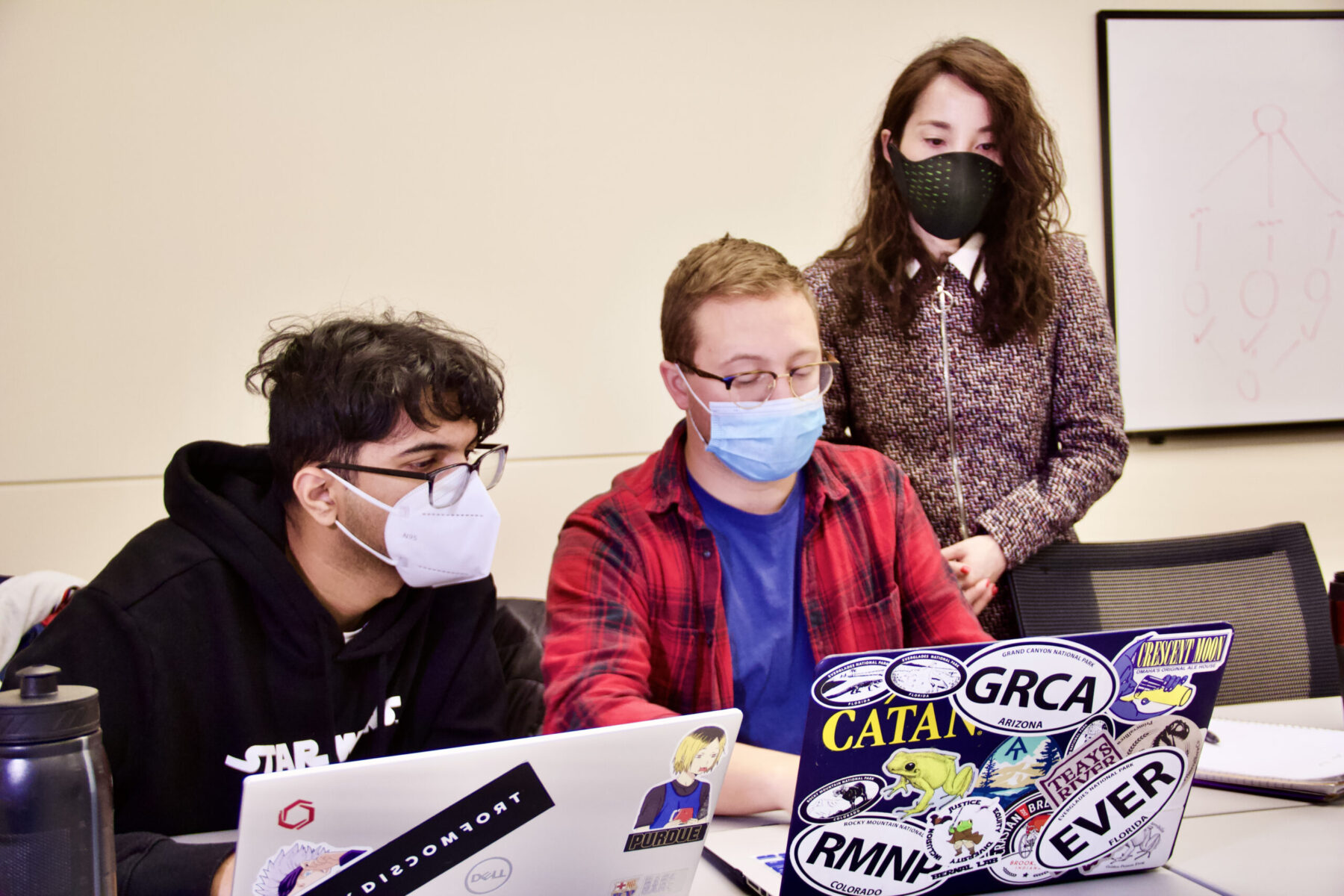Nursing professor’s public health research prowess shines in Purdue Data Mine

Nursing Assistant Professor Qinglan Ding, right, checks on the work of some of her Data Mine students.Tim Brouk
Written by: Tim Brouk, tbrouk@purdue.edu
From COVID-19 trends to youth vaping cessation, big data has a big presence in health sciences.
The Purdue University Data Mine has trained students from all majors to work with and analyze large data sets to tackle numerous national and world problems. Human health touches many of these.
Qinglan Ding, assistant professor in the School of Nursing, has instructed cohorts of young Data Mine researchers, many of whom live together in Hillenbrand Hall and work together on projects that have a public health focus.
“These students are mostly not coming from the health sciences majors,” said Ding, who joined the Data Mine in 2021 to help with COVID-19-related projects. “That’s why we are excited. We got them interested in health sciences. Most of them have some data or programming skill, but they don’t have the health sciences pieces.”
The Data Mine formed as a statistics learning community in 2014. It has since grown rapidly, comprised of about 20 learning communities of various disciplines.
Recent semesters have garnered international collaboration from universities in the Middle East and North Africa (MENA). Ding’s students have presented research to their MENA counterparts and vice versa over Zoom. They’ve been able to gain knowledge and perspective from faculty members from overseas institutions like Hasheimte University in the Hasheimte Kingdom of Jordan.
“These guest lectures focus on how to handle data to facilitate analysis,” said Ding, whose own research concentrates on sleep and metabolic heath. “We want to give the students the experience of international collaborations.”
The large data sets used by the students during their research projects come from the Data Mine’s collection; online sources, such as the Centers for Disease Control and Prevention and the Food and Drug Administration; or from overseas, shared by their new international colleagues. The students develop their own research questions from the data sets. Students can collect their own data too.
Restless legs and teenage smokers
A typical class in the Data Mine sees Ding and her teaching assistants walking around the classroom while undergraduate and graduate students huddle in their groups around laptops. There is much discussion and energy permeating the room inside Burton D. Morgan Center for Entrepreneurship.
The projects are as varied as the backgrounds of the students. First year data science students work alongside biomedical engineering graduate students like Ana Kirby. She and her group are utilizing a survey of 5,000 U.S. adults to explore the cardiovascular health of people suffering from restless leg syndrome, which has been known to affect sleep in adults.
“We looked at how restless leg syndrome affects obesity and hypertension with variables like diet and physical activity,” Kirby explained. “We came up with a composite score in trying to find what variables would affect your sleep the most.”
Purusharth Mier, an industrial engineering master’s student, and his group analyzed tobacco use of youth in the MENA region to see how the numbers line up with teenage tobacco use in the United States. Mier got hooked on research as an undergraduate, and he wanted to jump into a project related to healthcare.
“This experience has helped me ace a lot of my courses now outside of the Data Mine,” Mier reported. “This experience has given me a lot of real-time knowledge of how to do statistical analysis, how to do a research proposition and how to finalize a research question based on the statistical input or data sets you may have.”
Mier and his group started with 2016 survey data from Jordan and Iraq with plans to compare the sets with similar findings in the U.S. from 2020. They tackled the question of how advertising impacts youth tobacco use in MENA and the U.S. When findings weren’t as impactful, the group added vaping and e-cigarette use into the mix. This unhealthy habit was much more prevalent in both areas for youth, Mier said. For a better focus, they ditched the MENA data to concentrate on the more recent U.S. data and illustrate a growing health concern in America.
“We found e-cigarette use is steadily rising, and it’s much easier for underage users to buy them,” Mier stated. “Throughout this experience, I’ve gained a lot of insight of how an industrial engineer using statistics can have an impact on healthcare.”
Zachary Hanson and Avi Khurana are first-year data science majors who are analyzing and comparing MENA’s COVID-19 comorbidity rates with those of the United States. Their group is using about 50 different data sets with 73 different independent variables to find any correlation between the variables and the number of deaths per 100,000 per country. This huge project has its challenges, but the work could lead to meaningful impact.
End goals
After combing through at times millions of data points, considering variables and formulating answers to their research questions, Ding’s students present their findings. Depending on the success of the research, a paper could be submitted, making the students published researchers.
Ding has appreciated her semesters in the Data Mine. The experience has allowed her to stretch her own research muscles, and she has enjoyed teaching students of many different fields of study and research experience levels.
“We teach them data programming, statistics and machine learning and how to integrate it all into health sciences research,” Ding said. “Especially with COVID going on, I think it’s very important to have this, along with collaborating with other countries or even to help other countries.”